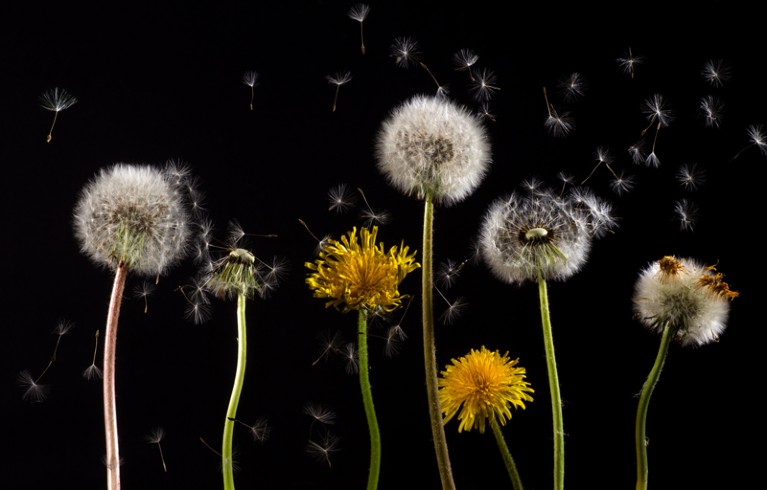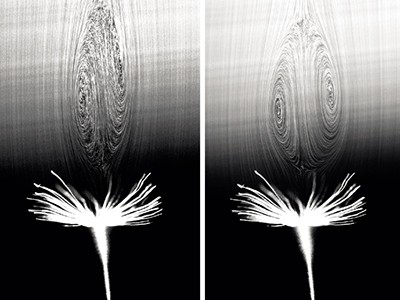
Dandelion seeds float thanks to a previously unknown source of lift.
The English poet and artist William Blake was no fan of the reductionism of Isaac Newton. True discovery, and therefore knowledge, Blake insisted in his poem ‘Auguries of Innocence’, was to be found in the everyday, where a world could be seen in a grain of sand and “heaven in a wild flower”.
Today, we know of exotic states of matter that can slow the vast speed of light to a mere sprint. And astronomers have spotted more than 3,800 planets in more than 2,800 distant stellar systems: a staggering rate of discovery, given that the first confirmed detection of a planet orbiting another star similar to the Sun was as recent as 1995.
None of this should blind us to the fact that — as Blake suggested — some of the most surprising discoveries come from the world of the familiar. No one has visited an exoplanet, but most people know what a dandelion looks like. This flower (Taraxacum officinale) is found worldwide. And, as many a child discovers to their delight, when a dandelion sets seed, the flower (actually, hundreds of tiny florets) turns into a mass of seeds known as a dandelion clock. Each seed is suspended from a parachute-like stalk — easily released by a puff of breath.
Read the paper: A separated vortex ring underlies the flight of the dandelion
The parachute is a bunch of bristles called a pappus. Each pappus carries around 100 filaments, each attached to a central point, rather like the head of a chimney sweep’s brush. Just like a parachute, it increases aerodynamic drag, slowing the descent of each seed and allowing it, once aloft, to be wafted kilometres from the parent plant. So much we know.
Here’s the surprising part — the mechanism of this dispersal was unknown until now. As researchers write in Nature this week (C. Cummins et al. Nature https://doi.org/10.1038/s41586-018-0604-2; 2018), the bristles are arranged so that when the pappus falls, air flows between them and creates a low-pressure vortex, like a smoke ring. This vortex travels above the pappus and yet is not attached to it, an invisible yet faithful familiar that generates lift and prolongs the seed’s descent.
The key lies not in the bristles of the pappus, but in the spaces between them. If projected on to a disc, the bristles together occupy just under 10% of the pappus’s area, and yet create four times the drag that would be generated by a solid disc of the same radius. The study shows that air currents entrained by each bristle interact with pockets of air held by its neighbours, creating maximum drag for minimum expenditure of mass. The pappus’s porosity — a measure of the proportion of air that it lets pass — determines the shape and nature of the low-pressure vortex.
All falling objects, from feathers to cannon balls, create turbulence in their wake. But it takes a rare combination of size, mass, shape and, crucially, porosity for the pappus to generate this vortex ring. Size is also particularly important, because from the point of view of something as small as a pappus, the air is appreciably viscous. At such a scale, a parachute consisting of a bunch of bristles is as effective as the aerofoil found in larger seeds that disperse from taller plants — such as the winged seeds of the maple. In the same way, the tiniest insects do not fly with solid wings, but swim through the air using ‘paddles’ made of bristles.
It’s an example of how evolution can produce ingenious solutions to the most finicky problems, such as seed dispersal. There are many things unknown that are smaller than atoms, or larger than galaxies, or billions of years away in time. But there are secrets held by things that we take for granted — things on a human or near-human scale — that seem all the more precious for it. Heaven in a wild flower, even.

 Read the paper: A separated vortex ring underlies the flight of the dandelion
Read the paper: A separated vortex ring underlies the flight of the dandelion
 Mechanisms of long-distance dispersal of seeds by wind
Mechanisms of long-distance dispersal of seeds by wind
 The aerodynamics buzz from mosquitoes
The aerodynamics buzz from mosquitoes


